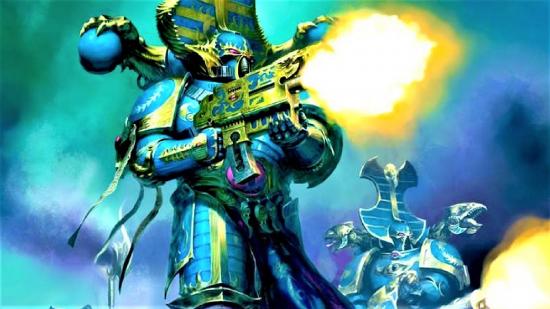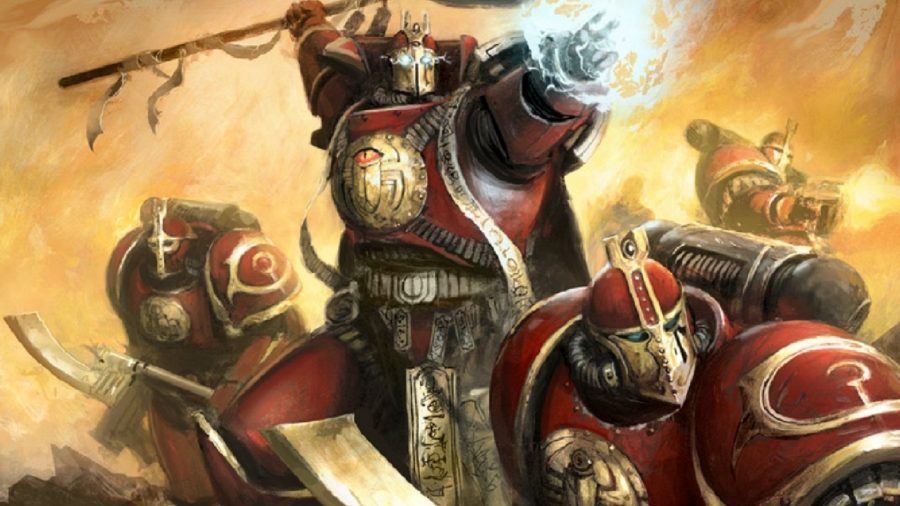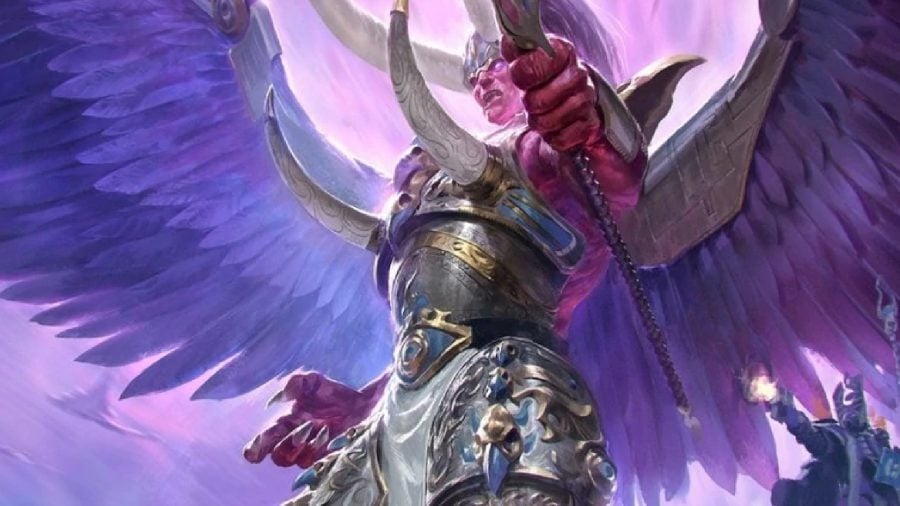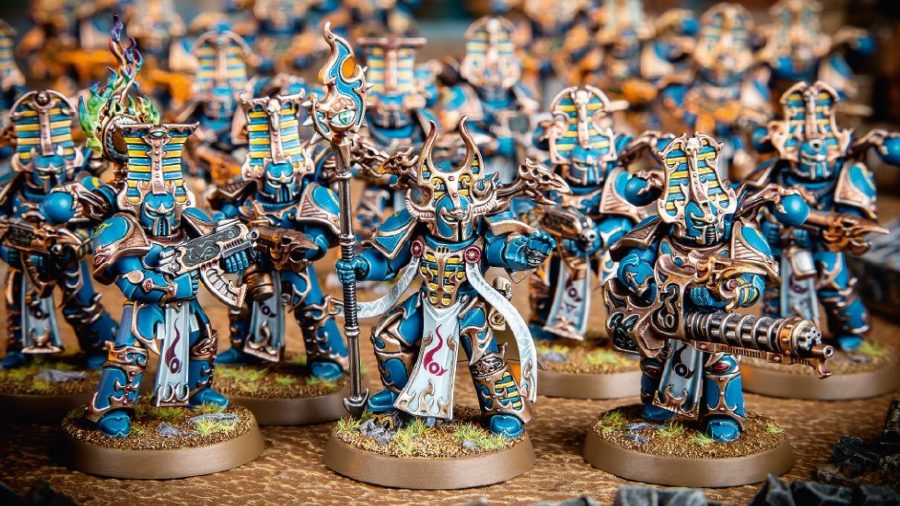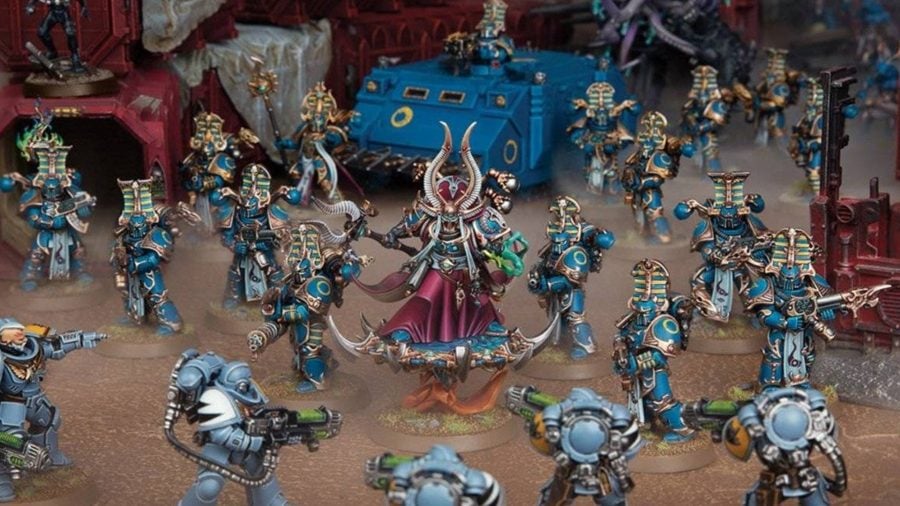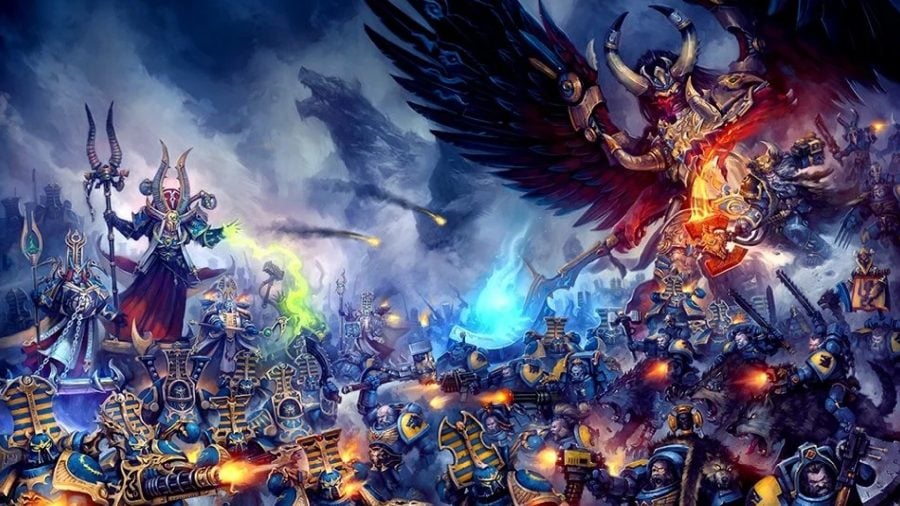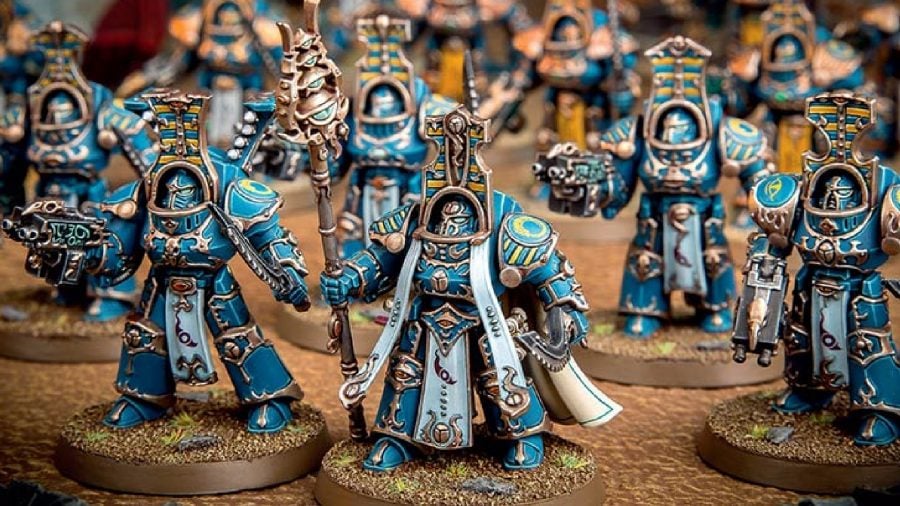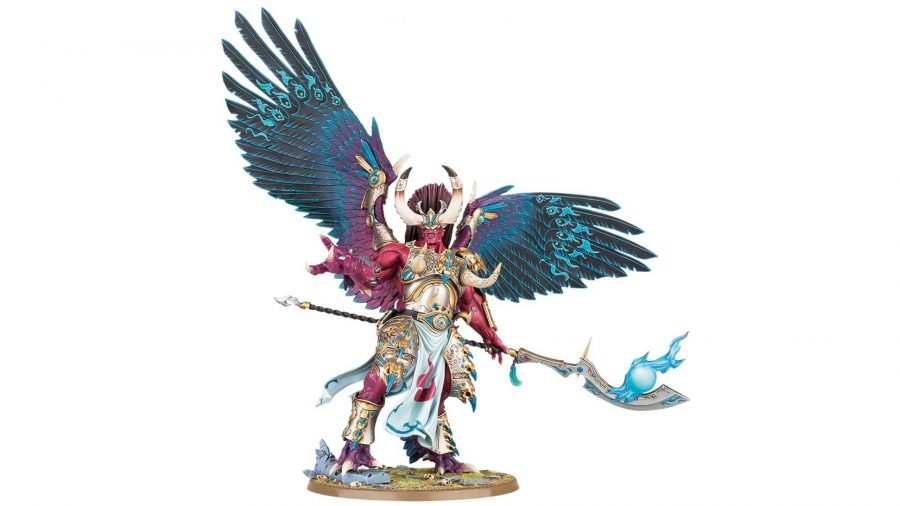Warhammer 40k’s Thousand Sons may appear, at first glance, closer to regular Space Marines than many of their heretical Chaos Space Marine brothers – but Chaos comes in many flavours. Followers of Nurgle, like the Death Guard, focus on spreading disease like happy little plague cherubs; denizens of Slaanesh prefer to delve into the worst excesses of the flesh and the mind.
But Tzeentch is the Chaos God of intrigue, magic, and change. Unknowable and mystic beyond all cognition, this god’s chosen instruments on the mortal plane are the Thousand Sons, the fallen Chaos Space Marine children of Magnus the Red. The Thousand Sons are as inscrutable as the god they call their patron. Obsessed with magic, plotting, and making sure they don’t crumble into dust, they’re found behind many of the nefarious schemes which bedevil the Imperium of Man.
On the tabletop, the Thousand Sons share many similarities with normal Chaos Space Marines – indeed, there’s much crossover in terms of the models available to them – but they remain unique enough to warrant their own rules and Codex.
If you’ve tap danced around the periphery of the boys in blue and gold, without diving into collecting them – or if you’re simply new to Warhammer 40k and you’ve taken a shine to their stylish Ancient Egyptian aesthetics – here’s our look at who the Thousand Sons are, how to start collecting your own army, and how they perform in the current edition of the game.
As with many Warhammer 40k Chaos factions, we’d better start at the beginning with Thousand Sons lore – you’ve got to understand how it started before we see how it’s going…
Thousand Sons Pre Heresy
Much like many Space Marines who fell to Chaos, the seeds of the Thousand Sons’ downfall were laid early. If there was a beginning to their corruption it came at the moment of their conception: their gene-seed harvested from their Primarch, Magnus the Red, was tainted.
This unwittingly led to two effects. First, they became much more attuned to the warp, with more Psykers awakening amongst their ranks than in any other legion. The second effect was much more harmful: the very flesh of the marines began to mutate. Many Thousand Sons Space Marines had to be locked away in stasis while a cure was investigated, with those who survived the flesh-change receiving a boon to the strength of their psychic powers.
Eventually, a cure was found – though it, too, arrived with as much curse as benefit. Like many of the Space Marine chapters, the Thousand Sons were separated from their Primarch, and eventually found him on the planet of Prospero. Once reunited, he set about stabilising their genetic structure, enacting a mysterious ritual which cured his gene-sons – but left only a thousand of them alive.
It appears that this ‘cure’ came from a Faustian pact with the Chaos God, Tzeentch, the initial payment being one of Magnus’ eyes. Nevertheless, seemingly cured and reunited with his Thousand Sons, they set out on the Great Crusade, bringing innumerable worlds into ‘compliance’ under the banner of the Imperium.
Again, however, misfortune was to strike the Thousand Sons. Their warp-shaping powers had grown considerably, and with them their lust for knowledge and magical secrets, causing many of their fellow Astartes to distrust them.
Sons of Nurgle: Read our Warhammer 40k Death Guard guide
This came to a head at the infamous Council of Nikaea, where psychic powers were banned by Imperial Edict – no Space Marine could ever again use psychic powers, or they would face punishment by the Emperor Himself.
Of course, the Thousand Sons didn’t pay the diktat much mind; they saw it a form of cowardice in the face of unbelievable power. And it was through continuing to use this power, walking the web of possible futures, that their primarch Magnus the Red made his most fatal mistake.
Magnus the Red
Magnus, the Primarch of the Thousand Sons, was raised by sorcerers on the planet Prospero, and had always believed that the ultimate good was knowledge, with ‘magical’ (psychic) power merely a tool in the pursuit of that ideal. Despite being censured by the Edicts of Nikea, Magnus continued to grow his powers and learn things he shouldn’t have – including uncovering the impending betrayal of Horus Lupercal, long before this was known back on Terra.
Marshalling his magical forces, he used all his power to send a message through the Immaterium to his father, the Emperor of Man. To say this didn’t go to plan is quite the understatement. Not only did he cause the deaths of millions on Terra as he fought his way past his father’s psychic defences, he inadvertently tore a warp rift into the throne room itself, letting the forces of Chaos in with him. This didn’t just anger the Emperor; at a single stroke, it ruined plans he had been pursuing for millennia. Suddenly, the bright, ascendant future the Emperor had envisioned for humanity was lost – and it was all Magnus’ fault.
Chastened, Magnus fled back to his corporeal body on Prospero, whilst, at the Emperor’s orders, the forces of Leman Russ and his Space Wolves gathered to inflict execution on Magnus and all the Thousand Sons. During the ensuing slaughter, Magnus awoke from his misery and, to escape destruction, teleported his remaining marines to a hitherto unnamed planet deep within the Eye of Terror, sealing forever their fate as allies to Chaos (and to Tzeentch in particular).
Worst of all, the flesh-change had returned, and Magnus, now merged with a daemon, became both more, and less, than he had been. It was left to his disciple, Ahzek Ahriman, to find a cure for the rapidly dwindling Thousand Sons. His answer was The Rubric: a spell that intended to bring only a cure – but which instead brought death to every marine afflicted by the flesh-change, turning them to dust, and leaving their spirits to haunt their armours as semi-living automatons.
Frakking machines: Our guide to 40k’s Adeptus Mechanicus
In a rage, Magnus banished Ahriman and his followers from the newly-named Planet of Sorcerers forever. Now, Ahriman hunts the universe for forbidden secrets, while Magnus plots and plans in the name of Tzeentch, only emerging to enact long-awaited vengeance on the sons of Leman Russ.
Thousand Sons Codex
For many factions and forces in the 9th edition of Warhammer 40,000, the process of getting a codex has been one of evolution. The Thousand Sons, however, have experienced a revolution, with the faction being almost redesigned in totality for the new edition.
The 9th Edition Thousand Sons Codex is utterly essential for anyone planning on playing the blue and gold boys (or red and gold if you prefer their pre-heresy colour scheme). This codex not only contains the rules that explore the Thousand Sons and their myriad psychic powers, it also introduces new rules for existing Chaos Space Marine models that may not have rules elsewhere, enhances Magnus the Red, and gives the Thousand Sons their own Crusade rules for uniquely Tzeentchian narrative series of games. As such, this isn’t just the ideal codex for anyone planning to play Thousand Sons; it also contains much to benefit Chaos Space Marine players, as well as anyone who’s as interested in the backstory and lore of the sorcerer-marines as we are.
Thousand Sons Tactics
Playing Thousand Sons on the 9th edition tabletop is a tricky thing to do. This is partly because, while they may seem to be simply a psychic-flavoured re-skin of the vanilla Chaos Space Marine faction, in reality, they are vastly different to their ‘mainstream’ chaotic brethren in many key ways.
The first thing that sets the Thousand Sons apart is their Cabbalistic Rituals. Every turn, during your Psychic Phase, you will generate Cabal Points for each of your units that still live and exist on the battlefield. These must be spent during the Psychic Phase they’re generated in, and you can spend them in a variety of ways. These range from making a psychic power immune to being denied, through to inflicting extra mortal wounds on top of a damage-dealing spell like Smite. Ouch.
See the future: Our guide to Warhammer 40k codex release dates
In addition to Cabbalistic Rituals, a new key Thousand Sons ability is the Infernal Pact. These work much the same as Chaos Space Marine Prayers, allowing the new Infernal Master model to cast various effects, with six to choose from.
Some of these are quite powerful and should be incorporated into your Thousand Sons tactics, like Bladed Maelstrom, which deals a mortal wound to an enemy unit and gives it -2 to Advance and Charge for a turn. Capering Imps slaps the benefits of Cover off an enemy, and Glimpse of Eternity gifts you a re-roll of a single die until the next Command Phase.
Thousand Sons psychic abilities
Of course, one of the key reasons to play Thousand Sons is their cornucopia of psychic powers. With Tzeentch, the God of Magic, as their patron, it’s understandable that they’d have a lot to choose from, and the Thousand Sons Codex doesn’t disappoint.
Here are some of the psychic powers you’ll spend a lot of time with if you’re planning on mastering Thousand Sons tactics:
- Doombolt – this ‘Smite Plus’ spell allows you to drop three mortal wounds on the nearest unit, which can be devastating when used correctly.
- Weaver of Fates – this gives a 4+ invulnerable save to a nearby Thousand Sons unit. With many Thousand Sons being a little fragile, this one’s crucial for offsetting some of the damage they’ll take.
- Glamour of Tzeentch – similar to Weaver of Fates, this spell boosts a nearby unit’s survivability by making them harder to hit, adding a -1 to hit penalty on attacks targeting them.
There are, of course, many other psychic powers that all have their uses depending on what your strategy is. With 18 to choose from, the Thousand Sons player will never be short of warp mischief to lob around the board.
Thousand Sons stratagems
The Thousand Sons also received a boost to their stratagems in the 9th edition of Warhammer 40k. Many of these stratagems can be incredibly powerful in the right hands, with a little thought and preparation you can lay down some devastating rules.
Some of the best stratagems for Thousand Sons in 9th edition are:
- Unwavering Phalanx – depending on the size of the target unit, this can cost between 1 and 3CP to cast, but what it does can really help you survive a tricky round. This reduces all damage by 1 (to a minimum of 1) that a unit receives during the Shooting Phase.
- Inhuman Savagery – for 2CP you can re-roll all hit rolls on a Tzaangor unit. Chances are this means they’ll hit, and they’ll hit hard.
- Metaphysical Focus – only 1CP and a Psyker can cast a psychic power in a phase where they have already undertaken a psychic action, allowing you to use more of your tasty powers each turn.
There are a tonne of stratagems you can browse through – 35 of them to be exact – giving the Thousand Sons a utility and breadth of play that they sorely lacked in previous editions.
Thousand Sons weaknesses
We’ve spoken about what makes the Thousand Sons unique and powerful on the battlefield, it’s time to address the shortcomings. There are two main issues to be aware of when playing Thousand Sons, and you will have to take care to avoid their pitfalls.
The first is that, outside of the default invulnerable save many Thousand Sons units have, they can be quite easy to kill. You won’t have many options that can act as a ‘tank’ on the battlefield, with Toughness and Wounds stats being scarce across the board. You’ll have to rely on canny tactics, maneuvering, and judicious usage of stratagems and spells to stay alive, take objectives, and give your opponent a bloody nose wherever possible.
Golden boys: Read our Warhammer 40k Adeptus Custodes guide
The other issue is in terms of damage output. Thousand Sons excel in the Psychic Phase and, with Inferno Bolters equipped on many Rubric Marines, they are brilliant at wiping out Space Marines and other, lesser units – but there’s not much in their roster that can crack heavy armour. If you’re looking for a big weapon to punch a hole in something, then the Thousand Sons will leave you wanting.
That said, the Thousand Sons are, quite frankly, in rude health in 9th edition. Unlike previous editions where they may have been considered an afterthought, the Thousand Sons feel more like a full faction in the 9th edition of Warhammer 40,000 – and, for many fans of magic dusty space-Egyptians, it’s about time.
How to start collecting Thousand Sons
When looking at starting your own Thousand Sons army, the first place to look is the Start Collecting! Thousand Sons box set. It contains several core Thousand Sons units, as well as one of the best psykers the game has to offer, so simply cannot be missed if you’re building your own magical army. Inside this box you’ll find 10 Tzaangors ( your close-combat specialists), ten Rubric Marines, who’ll deal with anything at range, and Ahriman.
Ahriman deserves special mention here as, while he’s not on the level of Magnus the Red (more on him in a moment), he’s still an incredibly powerful psyker. He gains re-rolls on both casting psychic powers and Deny the Witch attempts, has a beneficial re-roll aura, and even has an improved invulnerable save. Generally speaking, if you have Ahriman’s model, you’re playing Ahriman’s model.
If you’re looking to expand your gun-line you can’t go wrong with more Rubric Marines. Ten is a great start, but it’s only a start and to really start pumping out some numbers, you should start investing in a big brick of them. To help them stay alive a little longer, we’d also recommend some Chaos Cultists, as they’re cheap, and die easily, but are just dangerous enough that they need to be targeted first.
For something a little tougher, to plod forward and take the battle to the enemy, Scarab Occult Terminators are the Thousand Sons variant of a Warhammer 40,000 classic. They have excellent stats for shooting, combined with some strong armour which should see them survive the battle. In terms of weapons, the Inferno Combi-bolter can mow down enemy units in moments, dealing a huge amount of damage to enemies like Space Marines with an almost embarrassing amount of ease.
Wakey wakey: Read our guide to Warhammer 40k Necrons
As Thousand Sons units tend to suffer from poor defences, a Chaos Rhino can be a key component in getting your troops where you want them, alive. The Thousand Sons variant will also gain a 5+ invulnerable save, making it much tougher than standard Chaos Rhinos. Absolutely valuable, and nothing to be sniffed at.
Finally, we come to Magnus the Red. This Daemon Primarch has, on the whole, seen a huge array of buffs compared to previous editions. This makes Magnus the Red’s model not only a miniature wonder to own and paint, but almost essential on the battlefield when it comes to larger games.
He gets three Warlord traits, has an aura that offers re-rolls to nearby units, doesn’t suffer Perils of the Warp, gains +2 to psychic tests and re-rolls tests, can deal 3D3 with his Smite-a-like power, and has 8 attacks in melee by default. If that’s not enough, he can cast or deny three powers every Psychic Phase and can choose powers from the entire panoply of Thousand Sons abilities.
Now you should be more equipped to face the deadly terrors of knowledge that come with embracing the Thousand Sons. Don’t forget what you’ve learned; always remember that Tzeentch has a place for all of us in their grand scheme, and be happy in the part you have to play.
